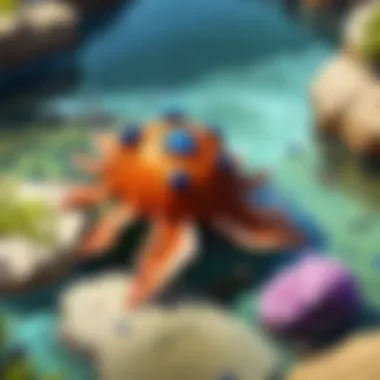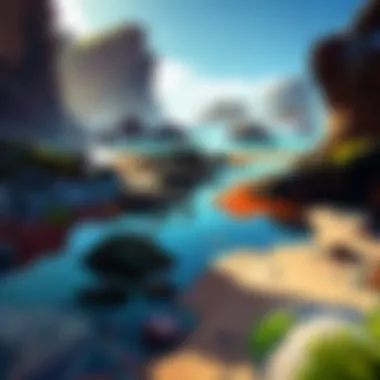Exploring the Rockpool Ecosystem: A Comprehensive Guide


Intro
Rockpools are fascinating coastal ecosystems that offer a unique glimpse into marine life. Found in areas where the ocean meets solid land, these small bodies of water play a critical role in supporting various species. From colorful sea anemones to hardy barnacles, rockpools are home to an array of organisms specifically adapted to survive their fluctuating environments. However, understanding these ecosystems is essential for their preservation and protection.
This guide aims to explore the intricate dynamics of rockpools, detailing their ecological value, biodiversity, and the threats they encounter. From their biological interactions to their importance in education and conservation efforts, rockpools represent both ecological hotspots and fragile environments worth safeguarding. By delving into this subject, we can appreciate the multifaceted roles these marine microhabitats play along our coastlines.
Foreword to Rockpools
Rockpools are not just patches of water surrounded by odd-looking rocks; they are vibrant ecosystems, often overlooked but essential to our coastal environments. They provide habitat for a multitude of species, each adapting uniquely to the ebb and flow of tidal changes. Understanding rockpools is crucial for grasping the broader complexity of marine environments.
Definition and Characteristics
Rockpools are shallow, depressions in rocky shorelines that fill with seawater at high tide. They expose a rich variety of organisms, such as small fish, crabs, sea anemones, and various algae. This diverse habitat can vary in size, type, and ecological function.
The characteristics of rockpools are defined by several key elements:
- Salinity fluctuations: Rockpools experience changes in salinity due to evaporation and tidal replenishment.
- Temperature variation: Sunlight and exposure influence temperature, leading to environments that can be quite warm compared to the open sea.
- Spatial heterogeneity: Varied structures like micro-habitats within rockpools harbor different life forms, providing stability within a dynamic environment.
These elements lead to a complex interplay of species within rockpools; many evolve to cope with these harsh conditions, showcasing resilience in nature.
Formation and Location
Rockpools form through specific geological and hydrological processes. They emerge primarily from the processes of erosion and wave action on rocky shorelines. Over time, these interactions create indentations that eventually become rockpools. Locations vary greatly—these ecosystems can be found on rocky coasts globally, from the rugged shorelines of Scotland to the warm waters of the Mediterranean.
Key characteristics of rockpool formation:
- Wave action: Extreme weather, such as storms, helps carve deep pools, contributing to their development.
- Regional differences: Local tidal ranges and geographical features influence how these ecosystems are shaped.
Coming across a rockpool is often met with awe due to their hidden complexity. They serve as both a source of wonder and a repository for critical ecological research.
Ecological Importance of Rockpools
Rockpools are not just picturesque features along coastlines; they play a vital role in the health of marine ecosystems. Understanding their ecological importance gives insight into how these fragile environments support a wide array of life forms. By maintaining biodiversity, providing shelter, and serving as nurseries for young fish and invertebrates, rockpools are essential to coastal health and resilience.
Microhabitats in Coastal Ecosystems
In the diverse coastal landscape, rockpools function like miniature ecosystems. They create isolated pools formed during low tides which hold water for varying periods. These conditions lead to distinct environmental zones characterized by fluctuations in salinity, temperature, and exposure to sunlight. Each rockpool becomes a habitat facilitating unique organisms.
Rockpools are critical for many organisms.
- They provide refuge from wave action: The walls of rockpools shield smaller organisms, allowing them to thrive in otherwise perilous environments.
- They offer various resources: Nutrients flow from incoming tides, assisting denizens in food acquisition.
- They enable reproduction: Species like anemones and certain fish often utilize rockpools for breeding, providing a safe area for juvenile growth.
The conditions within rockpools make them vital study areas for ecologists looking into climate adaptability and resilience of species.
Role in Biodiversity


Rockpools are biodiversity hotspots. Ary multiple species co-exist within these confined spaces. This diversity supports a complex web of life, ranging from primary producers like seaweeds to various herbivorous and carnivorous animals.
The biodiversity in rockpools aids in:
- Ecosystem Stability: Diverse species contribute to resilience against disturbances. Through different roles such as producers, consumers, and decomposers, they maintain environmental balance.
- Research Opportunities: Marine biologist have long discovered novel species in rockpools. They continue to be pivotal in biological studies, aiding in the understanding evolution and species adaptation.
- Interconnected Niches: Each species occupies a specific niche within the rockpool. For example, species of snails graze on algae, while crabs feed on detritus. This interconnectedness is crucial for maintaining a functional ecosystem.
Rockpools exemplify localized diversity and are essential for broader conservation efforts. They illustrate how small ecosystems can be integral components of larger ecological networks.
The intricate interactions within rockpools not only highlight their significance to regional biodiversity but also serve as indicators of broader environmental health.
Flora and Fauna of Rockpools
Flora and fauna constitute the heartbeat of rockpools, making them bustling microhabitats within coastal regions. The delicate balance of these ecosystems depends heavily on the diverse species that inhabit them. By examining the specific plant types, animal variations, and interactions between them, we gain insight into the critical roles they play in maintaining ecological integrity. This understanding is essential for serious conservation efforts.
Common Plant Species
Rockpools are usually home to hardy plant species, perfectly adapted to fluctuating tidal patterns. A few outlines include:
- Seagrasses: These underwater plants provide shelter and food, forming an essential part of the habitat.
- Algae: Varieties like kelp and Fucus grow abundantly, giving rockpools their unique character as well as serving as primary producers.
- Saltmarsh vegetation: Plants such as Spartina can help stabilize sediment and play a vital ecological role.
Each of these plant species not only contributes to the biodiversity of rockpools but also forms a crucial foundation for other species. The overall health and resilience of rockpools often hinge upon maintaining healthy plant populations.
Animal Species Variability
When considering animal species within rockpools, variability stands out as a key aspect. Rockpools can support a spectrum of animal life, including:
- Crustaceans: Species like crabs and shrimp often dominate the ecosystem.
- Fish: Smaller types such as blennies and gobies inhabit these areas, which tend to rely on the structure and protection provided by algal growth.
- Mollusks: Abundant in many rockpool habitats, they integrate various roles into the ecosystem.
This variability highlights how rockpools serve as important nurseries for numerous marine organisms. These distinct animal populations help in recycling nutrients and provide unique interactions that drive the ecological dynamics of rockpools.
Inter-species Relationships
In rockpools, interactions among species create a complex web of connections. Notable relationships include:
- Predator-prey dynamics: Crabs, for instance, often prey upon smaller fish and mollusks. This balance of control helps regulate populations.
- Symbiotic relationships: Some species can depend on algae for shelter while the algae benefit from the nutrients released by animals.
- Competition: Certain animals may compete for food resources or space, which profoundly influences the population distribution.
The intricate inter-species relationships found in rockpools underscore the interconnectedness of coastal ecosystems. Each role, whether primary producer or top predator, defines the nature and complexity of these unique environments.
Understanding the flora and fauna of rockpools informs us about their ecological significance. The unique dynamics maintain biodiversity and promote healthy marine ecosystems. As we identify threats these ecosystems face, recognizing and preserving their flora and fauna becomes paramount in conservation discussions.
Human Interaction with Rockpools
Human interaction with rockpools is a crucial aspect of their existence. These ecosystems, while vibrant and complex, are increasingly affected by human activities. Internally, the study shows patterns of various behaviors that demonstrate how we relate with these rich marine habitats. Awareness and understanding of rockpools can enhance conservation efforts and encourage sustainable engagement.
Cultural Significance


Rockpools hold a significant cultural value. They have inspired artists, writers, and ecologists. Indigenous cultures around coasts may incorporate rockpools into their stories and traditions, often viewing them as sources of life and knowledge.
People often perceive these ecosystems as dynamic ecosystems full of mystery. Artists find inspiration in the interplay of form and color among the organisms residing within them. Writers use the distinctive allure of rockpools to convey deeper meanings and experiences related to nature.
Some communities engage in practices of gathering food from rockpools. This traditional knowledge has been passed down for generations, affirming a rich relationship with the marine environment. Harvesting must be done responsibly, demonstrating an understanding of the balance that exists in rockpool systems.
Recreational Activities
Recreational enjoyment of rockpools is prominent in coastal areas. People engage in various activities, such as exploring, swimming, snorkeling, and educational programs. These methods offer enjoyment while raising awareness of the intricate ecosystems that rockpools represent.
- Tide Pooling: Exploring rockpools during low tide gives a hands-on experience, revealing species in their habitats.
- Educational Tours: Local wildlife organizations often conduct instructive guided tours that help participants learn about inter-tidal habitats. This optional education can foster respect and curiosity.
- Photography and Art: The unique beauty of rockpools attracts photographers and artists who are eager to capture the vibrancy of marine life.
However, human interaction must be approached with care. Climbing on rocks or disturbing organisms can harm delicate environments. Developing sustainable recreational habits is vital for preserving the integrity of rockpool ecosystems and ensuring enjoyment can continue for future generations.
Human interaction when conducted mindfully contributes to the knowledge and health of rockpool ecosystems.
By recognizing the dynamic relationship we have with rockpools, strategies can be created to enhance appreciation and stewardship. Concrete actions encourage conservation while maintaining cultural interests. Understanding the role of rockpools is essential as they continue to inspire curiosity about the broader coastal environment.
Threats to Rockpools
Rockpools, while critical for marine biodiversity, face multiple threats that jeopardize their existence and functions. Understanding these threats is essential for their protection and the sustainability of coastal ecosystems. Addressing issues like climate change and pollution is necessary because they directly affect the delicate balance within rockpool environments.
Climate Change Impacts
Climate change plays a major role in the degradation of rockpool ecosystems. Notably, rising sea levels and increased ocean acidity significantly impact the organisms that inhabit these environments. A warmer climate leads to warmer water temperatures, which can disrupt mating and feeding patterns of various marine species. For example, certain mollusks, which may flourish in cooler waters, struggle in heat.
Furthermore, altered tidal patterns change the physical makeup of rockpools, potentially leading to habitat loss. This then destabilizes food webs, as species that depend on specific conditions may not survive under new temperatures or sedimentation patterns. Sea ice melting can also change salinity, resulting in an environment that is hostile for resident species. In summary, as climate variables shift, the resilience of rockpools is tested continuously.
Pollution and Human Activities
Pollution stems from industrial and urban development near coastlines and greatly affects rockpools. Chemicals, plastics, and waste materials often find their way into these ecosystems, reducing the water quality and harming the flora and fauna. For example, fertilizers washed into the ocean create nutrient overload leading to algal blooms that suffocate marine life. The toxic substances impact invertebrates and fish not only detrimentally but also disrupt entire ecosystems.
Human activities can further compound pollution problems. For instance, recreational activities, such as fishing and shoreline alterations, disturb habitat integrity. These actions can lead to overharvesting of certain species and create biodiversity loss. Additionally, mining and extensive coastal development alter the physical structure of rockpool habitats, leading to erosion and sediment displacement. Protecting these valuable ecosystems requires stringent regulations to prevent pollution and promote sustainable coastal development.
Rockpools are more vulnerable than many might think; protecting them requires coordinated efforts to address pollution and the impacts of climate change effectively.
Conservation of Rockpool Ecosystems
The conservation of rockpool ecosystems holds significant importance in maintaining coastal biodiversity. These unique habitats are essential not only for various marine species but also for the health of coastal communities and environments. Their conservation involves targeted efforts that include scientific studies, community engagement, and stringent policies meant to reduce human impact and climate change effects.
Conservation Efforts and Strategies
Efforts towards conserving rockpools entail multiple strategies aimed at tackling various threats. These can include:
- Protective Legislation: Establish laws that specifically protect rockpool environments from harmful developments.
- Habitat Restoration: Engage in revival efforts for damaged rockpool areas, which might include rebuilding habitats or cleaning pollution.
- Community Involvement: Mobilize local communities to maintain and protect these habitats through site watches and clean-up days.


Such approaches ensure that vulnerable species, like the keyhole limpet and various seaweeds, continue to thrive in their natural surroundings. Research plays a crucial role in it. Studying these ecosystems allows scientists to see the impact of different conservation strategies and interpret data-driven findings. Regular monitoring helps in adjusting strategies based on effectiveness and environmental changes.
Educational Initiatives
Education serves as a vital part of conserving rockpool ecosystems. It involves raising awareness of their fragile nature and underscoring the roles they play within the broader ecosystem. Initiatives might include:
- Workshops and Community Programs: These gatherings can educate participants about the flora and fauna found in rockpools.
- School Programs: School trips to rockpools can create early awareness among young individuals concerning marine ecology.
- Public Information Campaigns: Use social media and local organizations to spread information about the importance and the current threats faced by rockpools.
Engaging the public not only enhances understanding but also fosters a sense of responsibility. When communities recognize their role in protecting these ecosystems, participatory conservation can create lasting change. Raising consciousness is an investment into the longevity and sustainability of rockpool ecosystems.
Understanding the concept of conservation is not just vital for managing ecosystems but is crucial in fostering a culture of stewardship among future generations. The ways we interact with our environment today shape outcomes for tomorrow. It is our responsibility to protect such fragile ecosystems.
Conservation of rockpool ecosystems is, therefore, a collective effort. Each action taken, whether through targeted legislation, community engagement, or educational initiatives, contributes significantly to safeguarding these valuable coastal habitats.
Research on Rockpools
Research on rockpools is critical to understanding their ecological roles and the diverse life forms they support. These studies can yield insights into the complex interactions among inhabitants, the effects of environmental changes, and conservation strategies. It is essential to engage in research as it helps identify core qualities of rockpool ecosystems and emphasizes their importance in wider coastal environments. Moreover, advocates for marine conservation utilize research findings to shape policies and offerings that safeguard these unique habitats.
Current Studies and Findings
Recent studies into rockpool ecosystems focus on various critical aspects:
- Biodiversity assessments: Regular surveys document what species are present, helping to reveal shifts in populations over time. This can shed light on how species respond to disturbances.
- Climate impacts: With the rise in sea temperatures and acidification, understanding how stressors affect species behavior and growth is key. It shows resilience mechanisms in various organisms.
- Habitat quality: Chromatic indices and chemical tests provide insight into the overall condition of the substrate and water. Knowing how pollutants accumulate helps in presenting solutions to mitigate the effects.
Such extensive studies emphasize understanding not merely on a species-by-species level but on recognizing patterns and connections among them. By unveiling data collected from multiple locations, we gain informed recommendations for policy changes. For example, thorough mitigation strategies now focus on boosting species resilience.
Future Research Directions
Future research in rockpool ecosystems can take many exciting paths. Key areas for exploration include:
- Longitudinal studies: Follow populations of specific species over years to track adaptations and changes. This can present evidence of evolutionary responses.
- Impact of invasive species: Understanding how invasive organisms affect native biodiversity is vital for managing parks and wildlife.
- Citizen science involvement: More research can encourage participation from local communities to gather data and observe fluctuations within their rockpools. This practice not only raises awareness but can significantly contribute to research.
It is essential that researchers also focus on creating solutions inspired by findings. Holistic perspectives that incorporate various factors affecting rockpools will benefit further inquiry. Close cooperation between academics and conservation programs may start innovative strategies to fortify these delicate ecosystems.
Continual research and community communication is crucial to safeguarding rockpool habitats and promoting environmental stewardship in coastal areas.
The End
Rockpools embody a microcosm of coastal life. They represent critical habitats for various species, emphasizing the intricate web of interactions that does not limit to merely one species or one aspect of nature. In this conclusion, we encapsulate the essence of rockpools and underline their significance.
Summary of Key Points
- Rockpools serve as important ecological zones. They host diverse flora and fauna that adapt to fluctuating environmental conditions.
- Their role in biodiversity cannot be overstated; they support unique species combinations that contribute to greater coastal ecosystem health.
- Human activities pose substantial threats to these habitats, creating challenges for species that inhabit them.
- Conservation efforts and educational initiatives are pivotal in raising awareness and promoting protective actions for these ecosystems.
- Latest research highlights an urgent need to study the impacts of climate change and pollution on rockpool health, contributing to long-term preservation strategies.
Conclusion Quote: The delicate balances within rockpools display the interconnectedness of life at the edges of land and sea. Their protection is not just about preserving beauty, but also ensuring ecological diversity flourishes.
Call to Action for Conservation
Conservation of rockpools demands participation from everyone, from local communities to governments. Here are some suggestions to take action:
- Reduce Foot Traffic: Limit the impact humans have on rockpool habitats. Stick to well-marked paths to avoid disrupting fragile ecosystems.
- Participate in Clean-ups: Community beach clean-ups can alleviate pollution and safeguard this environment. Engage with local organizations aligned with marine health.
- Educate Others: Share your knowledge about rockpools. Understanding these ecosystems encourages responsibility and proactive stewardship.
- Advocate for Policies: Support policies that protect coastal habitats. Collaborate with environmental groups that push for legislation against harmful activities.
By recognizing the essential nature of rockpools, we acknowledge that protectig these ecosystems forms part of our responsibility to future generations. Engage, educate, and conserve; every effort counts against the challenges rockpools face.







